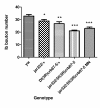Myosin VI contributes to synaptic transmission and development at the Drosophila neuromuscular junction
- PMID: 21745401
- PMCID: PMC3146895
- DOI: 10.1186/1471-2202-12-65
Myosin VI contributes to synaptic transmission and development at the Drosophila neuromuscular junction
Abstract
Background: Myosin VI, encoded by jaguar (jar) in Drosophila melanogaster, is a unique member of the myosin superfamily of actin-based motor proteins. Myosin VI is the only myosin known to move towards the minus or pointed ends of actin filaments. Although Myosin VI has been implicated in numerous cellular processes as both an anchor and a transporter, little is known about the role of Myosin VI in the nervous system. We previously recovered jar in a screen for genes that modify neuromuscular junction (NMJ) development and here we report on the genetic analysis of Myosin VI in synaptic development and function using loss of function jar alleles.
Results: Our experiments on Drosophila third instar larvae revealed decreased locomotor activity, a decrease in NMJ length, a reduction in synaptic bouton number, and altered synaptic vesicle localization in jar mutants. Furthermore, our studies of synaptic transmission revealed alterations in both basal synaptic transmission and short-term plasticity at the jar mutant neuromuscular synapse.
Conclusions: Altogether these findings indicate that Myosin VI is important for proper synaptic function and morphology. Myosin VI may be functioning as an anchor to tether vesicles to the bouton periphery and, thereby, participating in the regulation of synaptic vesicle mobilization during synaptic transmission.
Figures









Similar articles
-
Localization and mobility of synaptic vesicles in Myosin VI mutants of Drosophila.PLoS One. 2014 Jul 25;9(7):e102988. doi: 10.1371/journal.pone.0102988. eCollection 2014. PLoS One. 2014. PMID: 25062032 Free PMC article.
-
Nonmuscle Myosin II helps regulate synaptic vesicle mobility at the Drosophila neuromuscular junction.BMC Neurosci. 2010 Mar 16;11:37. doi: 10.1186/1471-2202-11-37. BMC Neurosci. 2010. PMID: 20233422 Free PMC article.
-
Neuroligin 2 is required for synapse development and function at the Drosophila neuromuscular junction.J Neurosci. 2011 Jan 12;31(2):687-99. doi: 10.1523/JNEUROSCI.3854-10.2011. J Neurosci. 2011. PMID: 21228178 Free PMC article.
-
Modulation of neuromuscular synapses and contraction in Drosophila 3rd instar larvae.J Neurogenet. 2018 Sep;32(3):183-194. doi: 10.1080/01677063.2018.1502761. Epub 2018 Oct 10. J Neurogenet. 2018. PMID: 30303434 Review.
-
Cell adhesion molecules in Drosophila synapse development and function.Sci China Life Sci. 2012 Jan;55(1):20-6. doi: 10.1007/s11427-012-4273-3. Epub 2012 Feb 8. Sci China Life Sci. 2012. PMID: 22314487 Review.
Cited by
-
Neural activity selects myosin IIB and VI with a specific time window in distinct dynamin isoform-mediated synaptic vesicle reuse pathways.J Neurosci. 2015 Jun 10;35(23):8901-13. doi: 10.1523/JNEUROSCI.5028-14.2015. J Neurosci. 2015. PMID: 26063922 Free PMC article.
-
Synaptic vesicle tethering and the CaV2.2 distal C-terminal.Front Cell Neurosci. 2014 Mar 7;8:71. doi: 10.3389/fncel.2014.00071. eCollection 2014. Front Cell Neurosci. 2014. PMID: 24639630 Free PMC article.
-
Involvement of unconventional myosin VI in myoblast function and myotube formation.Histochem Cell Biol. 2015 Jul;144(1):21-38. doi: 10.1007/s00418-015-1322-6. Epub 2015 Apr 21. Histochem Cell Biol. 2015. PMID: 25896210 Free PMC article.
-
Neurotransmitter Release Site Replenishment and Presynaptic Plasticity.Int J Mol Sci. 2020 Dec 30;22(1):327. doi: 10.3390/ijms22010327. Int J Mol Sci. 2020. PMID: 33396919 Free PMC article. Review.
-
Myosin VI and its cargo adaptors - linking endocytosis and autophagy.J Cell Sci. 2013 Jun 15;126(Pt 12):2561-70. doi: 10.1242/jcs.095554. Epub 2013 Jun 18. J Cell Sci. 2013. PMID: 23781020 Free PMC article. Review.
References
Publication types
MeSH terms
Substances
LinkOut - more resources
Full Text Sources
Molecular Biology Databases

